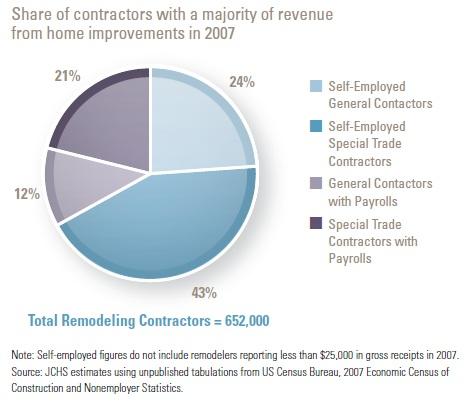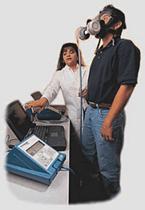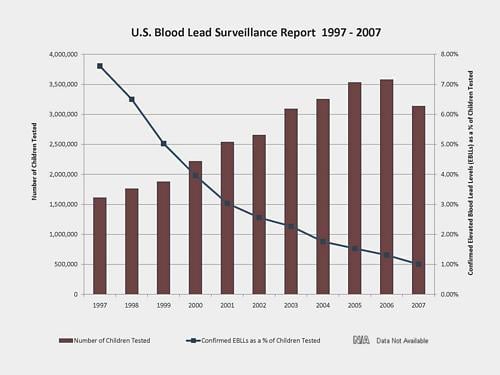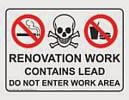EPA Report Card: How well are they doing with the RRP Rule?

Many news outlets and politicians have been using report card scores to express how well they think people, government policies and regulations are performing. Several politicians, government employees and even our president have provided their own self assessment scores as well. It is almost two years now since the EPA RRP Rule went into effect. I thought I would offer my own report card on how I think the EPA has performed so far in four areas regarding the RRP Rule. EPA is welcome to offer their own self assessment score.
Subject: Outreach about the rule
EPA has claimed to have done extensive outreach to consumers and the regulated community. They list a variety of methods used and places where ads and announcements were placed.
Report Card Score: D-
 In reality what they have done has not been effective. Either the message is not effective, the placement is not effective or both. According to a survey done by Professional Remodeler magazine 65% of remodelers surveyed estimated that less than 10% of their potential clients are aware of the rule. Only 5 percent think more than half of homeowners know about it.
In reality what they have done has not been effective. Either the message is not effective, the placement is not effective or both. According to a survey done by Professional Remodeler magazine 65% of remodelers surveyed estimated that less than 10% of their potential clients are aware of the rule. Only 5 percent think more than half of homeowners know about it.
On a recent webinar with EPA Officials Regarding RRP Public Awareness and Enforcement Efforts hosted by NCHH, I asked EPA officials if they were doing any tracking to check the actual effectiveness of their outreach efforts. They are not. Essentially the answer was that EPA is not a professional marketing organization and has no way of tracking results. But they said they will be doing more outreach…
Subject: Getting Firms Certified
EPA requires all firms doing renovation, repair and painting work on homes built prior to 1978 become EPA Certified Firms before performing or offering to perform such work.
Report Card Score: F

Before the rule rule came into effect EPA stated; "There are approximately 211,000 firms estimated to become certified to engage in renovation, repair, or painting activities." As of posting this blog EPA’s web site claims that EPA has certified 97,746 firms (118,885 firms including those approved by authorized states). According to a report by the Joint Center for Housing Studies at Harvard University, the most recent government census showed more than 650,000 businesses received a majority of their revenue by providing remodeling services in 2007 and that number does not include the large number of part-time, semi-retired, and “moonlighting” contractors reporting gross revenues of less than $25,000. I think we also know there are many illegally operating contractors as well that did not make it into the census count.
Admittedly not all remodeling companies work on pre-1978 homes. However, there are many other business types other than remodelers who disturb lead paint. One example is exterminators. According to Exterminator.com there are over 20,000 extermination companies in the US. Others who would need to become certified include landlords, property management firms, banks that own foreclosed properties, housing authorities, cities/towns and municipalities. (According to Google answers there are 18,443 cities, towns, villages, and other such governing groups in the United States, not including any island areas other than Puerto Rico) I am sure you could list other business and entity types that would fall under the rule. My best guess is that EPA has only certified about 10% of the firms that should be certified and has completely misjudge the number of firms affected by this rule.
As a side note, I contacted EPA to find out how many workers have become Certified Renovators so far. I was told they are still trying to decide how to count them…
Subject: Enforcement
There are 12 states that have taken over the rule so far. That leaves 38 states plus American Samoa, District of Columbia, Guam, US Virgin Islands and Puerto Rico under administration and enforcement by EPA.
Report Card Score: F
 So far EPA has only published one violation since the rule came into effect in April of 2010. On the other hand the state of Massachusetts took over the rule in July of 2012 and has published over 20 violation enforcements to date.
So far EPA has only published one violation since the rule came into effect in April of 2010. On the other hand the state of Massachusetts took over the rule in July of 2012 and has published over 20 violation enforcements to date.
Though not confirmable facts, one commenter on a LinkedIn discussion claimed “there are only 37 Certified Firms in Maui County when there are 1,500+ Licensed Contractors and double to triple unlicensed contractors”.
Industry insiders report EPA has been doing RRP investigations. EPA claims we will hear more about violations and enforcement very soon.
Subject: Protecting children and others from lead poisoning due to renovations
“The purpose of the Renovation, Repair, and Painting (RRP) Rule is to minimize exposure from lead-based paint dust during renovation, repair, or painting activities. This is a key effort in reducing the prevalence of childhood lead poisoning, particularly lead poisoning caused by housing contaminated by renovation activities. This will also minimize exposure to older children and adults who are also adversely impacted by lead-based paint dust exposure.” (From EPA Web site)
Report Card Score: Incomplete
 It is a fact that lead is poisonous and RRP activities can cause poisoning. However, EPA does not know how many children were actually poisoned by RRP activities before the rule came into effect. If you check any of the data it refers to RRP activities as the “likely source” of lead poisoning, not “the cause”. That being the case, EPA has no way to know if the RRP rule is making a difference or not. It is ‘likely” that it is helping. But, without knowing where EPA started and where we are now that the rule has been in place for almost a year, EPA has no idea if what they have been doing is effective enough and or if or where it can improve effectiveness within the rule.
It is a fact that lead is poisonous and RRP activities can cause poisoning. However, EPA does not know how many children were actually poisoned by RRP activities before the rule came into effect. If you check any of the data it refers to RRP activities as the “likely source” of lead poisoning, not “the cause”. That being the case, EPA has no way to know if the RRP rule is making a difference or not. It is ‘likely” that it is helping. But, without knowing where EPA started and where we are now that the rule has been in place for almost a year, EPA has no idea if what they have been doing is effective enough and or if or where it can improve effectiveness within the rule.
Unfortunately, the rule may also be causing more children to be poisoned than before the rule came into effect, because of EPA's inability to adequately enforce it. As reported in this press release, to keep costs down, consumers are hiring non-certified firms to work on their homes and the required lead safe-practices are not being used. Also, contractors are reporting that some realtors and insurance adjusters are falsely telling consumers that the rule does not apply at their homes based on location and or for the work they are having done. All of this has fostered an underground economy of contractors taking advantage of purposely ignoring the rule to keep prices down and improve their ability to sell jobs.
How do you think EPA has been doing with the RRP Rule so far? Consider using the comment area below to offer your own subjects and report card scores.

 Looking for accurate information about the EPA RRP rule?
Looking for accurate information about the EPA RRP rule? 
 Actually this is about helping spread the word to children and parents about avoiding the dangers of lead exposure.
Actually this is about helping spread the word to children and parents about avoiding the dangers of lead exposure.  I suggest renovators could use this video on their website. Consider creating an area on your site dedicated to the RRP Rule. Make it a place that offers information, advice and links that would help visitors understand the rule and the realities of lead exposure. If you do so you can send prospects and customers to your site to help pre-educate them prior to a sales call or before beginning work at their home.
I suggest renovators could use this video on their website. Consider creating an area on your site dedicated to the RRP Rule. Make it a place that offers information, advice and links that would help visitors understand the rule and the realities of lead exposure. If you do so you can send prospects and customers to your site to help pre-educate them prior to a sales call or before beginning work at their home. 



 Both sides of this issue have valid points to consider. Before we make rash decisions have we looked at the entire picture? We can do better than our politicians, but we must think before we act.
Both sides of this issue have valid points to consider. Before we make rash decisions have we looked at the entire picture? We can do better than our politicians, but we must think before we act. Whether the Opt Out comes back or not, what about the employees of the firms who intend on using this option? Did anyone ask those who are actually doing the work how they feel about their health risks? Will they have a voice without retaliation?
Whether the Opt Out comes back or not, what about the employees of the firms who intend on using this option? Did anyone ask those who are actually doing the work how they feel about their health risks? Will they have a voice without retaliation? I believe this law can create marketing and positioning opportunities to those who see it this way and in the process, keeps everyone safe – and for those who see it differently, it’s obviously a never ending source of complaints which has divided our industry at a time when we need each others’ back more than ever.
I believe this law can create marketing and positioning opportunities to those who see it this way and in the process, keeps everyone safe – and for those who see it differently, it’s obviously a never ending source of complaints which has divided our industry at a time when we need each others’ back more than ever. One big reality of the current recession is the need for everyone to cut back their budgets. This holds true for most Americans, businesses and nonprofits. It has now also started to become a reality for our government. A recent discussion posted to LinkedIn includes a link to an article that is titled
One big reality of the current recession is the need for everyone to cut back their budgets. This holds true for most Americans, businesses and nonprofits. It has now also started to become a reality for our government. A recent discussion posted to LinkedIn includes a link to an article that is titled
 Doesn’t it make sense to concentrate funding on efforts that would prevent lead poisoning to begin with, rather than justify that money from the government is needed to help those already poisoned? Why is it they are they still getting poisoned? Plus, it would probably be much less expensive to prevent the problem than it would be to deal with it after it has occurred.
Doesn’t it make sense to concentrate funding on efforts that would prevent lead poisoning to begin with, rather than justify that money from the government is needed to help those already poisoned? Why is it they are they still getting poisoned? Plus, it would probably be much less expensive to prevent the problem than it would be to deal with it after it has occurred.
 Workers with an occupational exposure to lead need to inform their doctors in order to give them all the background needed for an adequate evaluation of symptoms as possibly related to lead exposure.
Workers with an occupational exposure to lead need to inform their doctors in order to give them all the background needed for an adequate evaluation of symptoms as possibly related to lead exposure. Nervous system and kidney damage.
Nervous system and kidney damage. Miscarriages
Miscarriages High blood pressure
High blood pressure Digestive problems
Digestive problems International and domestic studies have shown elevated lead levels in humans consuming large and small game hunted with lead ammunition. Studies prove that regular consumption of game meat in adults and children found elevated blood lead levels compared with background levels, especially among children.
International and domestic studies have shown elevated lead levels in humans consuming large and small game hunted with lead ammunition. Studies prove that regular consumption of game meat in adults and children found elevated blood lead levels compared with background levels, especially among children. 

 Thanks to PR activities by NARI, Wall Street Journal Blogger
Thanks to PR activities by NARI, Wall Street Journal Blogger  Many point out that one of the consequences of the rule is that now more children have been put at risk for lead poisoning; for two reasons. The first is due to the fact that illegally operating contractors are under-bidding compliant contractors because they are ignoring the required lead-safe work practices and therefore creating lead hazards. The second is that homeowners are either doing the work themselves and or doing the demolition stage of the work themselves to avoid the added costs related to the rule’s required lead-safe work practices.
Many point out that one of the consequences of the rule is that now more children have been put at risk for lead poisoning; for two reasons. The first is due to the fact that illegally operating contractors are under-bidding compliant contractors because they are ignoring the required lead-safe work practices and therefore creating lead hazards. The second is that homeowners are either doing the work themselves and or doing the demolition stage of the work themselves to avoid the added costs related to the rule’s required lead-safe work practices. As Ben Franklin once said: “We must all hang together, or assuredly we shall all hang separately.”
As Ben Franklin once said: “We must all hang together, or assuredly we shall all hang separately.” On a web site by the name of
On a web site by the name of  Like construction workers who are exposed to lead in the course of their work, Gardeners should also consider that their skin and their clothes may become contaminated. Always wash your hands immediately after gardening and definitely before eating, drinking or smoking to avoid ingesting lead dust. To reduce the risk of bringing lead contaminated soil into the home, rinse and launder gardening clothing promptly. Being educated about the dangers of lead and ways to protect yourself as well as your family can help make sure you’re not growing a lead problem in your garden.
Like construction workers who are exposed to lead in the course of their work, Gardeners should also consider that their skin and their clothes may become contaminated. Always wash your hands immediately after gardening and definitely before eating, drinking or smoking to avoid ingesting lead dust. To reduce the risk of bringing lead contaminated soil into the home, rinse and launder gardening clothing promptly. Being educated about the dangers of lead and ways to protect yourself as well as your family can help make sure you’re not growing a lead problem in your garden. 


 When you remove all the smoke and mirrors from this rule, the EPA can prove two thoughts; 1 Some remodeling activities create dust 2 Lead paint dust can create or raise EBLL’s Independent of each other those two statements can be proven, but the combination (which is a major foundational reason for RRP) is not so clear. Why?
When you remove all the smoke and mirrors from this rule, the EPA can prove two thoughts; 1 Some remodeling activities create dust 2 Lead paint dust can create or raise EBLL’s Independent of each other those two statements can be proven, but the combination (which is a major foundational reason for RRP) is not so clear. Why? Since I can’t explain to the customer the need for this rule, I encourage my customers and prospects to contact their state and federal representatives and ask them to provide facts and figures to explain the need for the RRP rule. To assist them with this, I supply them with a letter to send to their representatives along with a stamped and addressed envelope. I encourage all other contractors to consider doing the same.
Since I can’t explain to the customer the need for this rule, I encourage my customers and prospects to contact their state and federal representatives and ask them to provide facts and figures to explain the need for the RRP rule. To assist them with this, I supply them with a letter to send to their representatives along with a stamped and addressed envelope. I encourage all other contractors to consider doing the same. 


